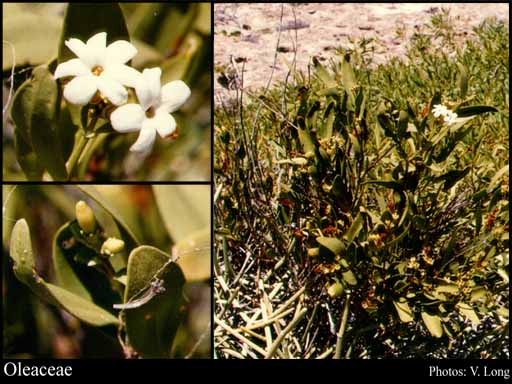- Reference
- Fl.Portug. 1:62 (1809)
- Name Status
- Current

Scientific Description
Common name. Olive Family.
Habit and leaf form. Trees and shrubs, or lianas; deciduous (often), or evergreen. Self supporting, or climbing; stem twiners, or scrambling. Jasminum, twining clockwise. Leaves opposite (nearly always), or alternate; petiolate; sheathing; simple, or compound; when compound, ternate, or pinnate. Leaf blades dorsiventral; when simple, dissected, or entire; pinnately veined; cross-venulate. Leaves without stipules. Leaf blade margins entire, or serrate, or dentate. Vegetative buds scaly. Leaves without a persistent basal meristem. Domatia recorded (from six genera and many species); represented by pits, or pockets, or hair tufts. Leaf anatomy. Hairs present; complex hairs present. Complex hairs usually peltate. Stem anatomy. Nodes unilacunar. Secondary thickening developing from a conventional cambial ring.
Reproductive type, pollination. Fertile flowers hermaphrodite (usually), or hermaphrodite, functionally male, and functionally female. Unisexual flowers present, or absent. Plants hermaphrodite (usually), or polygamomonoecious.
Inflorescence and flower features. Flowers solitary, or aggregated in ‘inflorescences’. The terminal inflorescence unit (when flowers aggregated) cymose. Inflorescences racemes, panicles or fascicles. Flowers bracteate, or ebracteate; fragrant (often), or odourless; regular; usually 2–6 merous; tricyclic, or tetracyclic. Free hypanthium absent. Hypogynous disk present (around the gynoecium), or absent; extrastaminal. Perianth with distinct calyx and corolla (usually), or sepaline (the corolla sometimes lacking); typically 8; 2 -whorled (usually), or 1 -whorled; isomerous. Calyx present, or present to vestigial (occasionally); 4(–15); 1 -whorled; gamosepalous; entire, or lobed; when not entire, lobulate, or blunt-lobed, or toothed (sometimes almost obsolete); valvate; regular. Corolla present (usually), or absent; when present, i.e. usually 4(–12); 1 -whorled; polypetalous (rarely, more or less), or gamopetalous; imbricate, or valvate (or induplicate-valvate), or contorted; regular. Fertile stamens present, or absent (from female flowers). Androecial members definite in number. Androecium 2 (usually), or 4 (rarely). Androecial sequence not determinable. Androecial members adnate (to the corolla), or free of the perianth; free of one another; 1 -whorled. Androecium exclusively of fertile stamens. Stamens 2(–4); reduced in number relative to the adjacent perianth; oppositisepalous; when corolla present, all alternating with the corolla members; filantherous, or with sessile anthers. Anthers dorsifixed, or basifixed; dehiscing via longitudinal slits; introrse. Fertile gynoecium present, or absent (from male flowers). Gynoecium 2 carpelled. The pistil 2 celled. Carpels reduced in number relative to the perianth. Gynoecium syncarpous; synovarious to eu-syncarpous; superior. Ovary plurilocular; 2 locular. Gynoecium median, or oblique, or transverse; stylate. Styles 1; apical. Stigmas 2 - lobed; dry type; papillate, or non-papillate; Group II type. Placentation axile. Ovules (1–)2(–50) per locule (usually 2, but Jasminoideae with 1, 4 or ‘many’); pendulous, or ascending; with dorsal raphe; usually collateral; non-arillate; anatropous, or amphitropous.
Fruit and seed features. Fruit fleshy, or non-fleshy; dehiscent, or indehiscent, or a schizocarp. Mericarps when schizocarpic, 2; samaroid. Fruit when non-schizocarpic, a capsule, or a berry, or a drupe. Capsules loculicidal. Fruit 1–4 seeded. Seeds endospermic, or non-endospermic. Endosperm oily. Embryo rudimentary at the time of seed release (e.g. Fraxinus excelsior), or weakly differentiated to well differentiated. Cotyledons 2. Embryo achlorophyllous; straight. Seedling. Germination phanerocotylar, or cryptocotylar.
Physiology, biochemistry. Aluminium accumulation not found. Photosynthetic pathway: C3.
Special features. Fruit oleac544.gif oleac545.gif oleac425.gif oleac617.gif.
Geography, cytology, number of species. World distribution: cosmopolitan, save for frigid regions. X = 10, 11, 13, 14, 23, 24. About 900 species.
Economic uses, etc. Edible fruit and edible and medicinal ‘olive oil’ from Olea europaea, cultivated trees and shrubs, timber trees (Jasminum, Osmanthus, Forsythia, Syringa, Ligustrum, Fraxinus, etc.
Keys
Western Australian Genera and Families of Flowering Plants — an interactive key
T.D. Macfarlane, L. Watson, N.G. Marchant